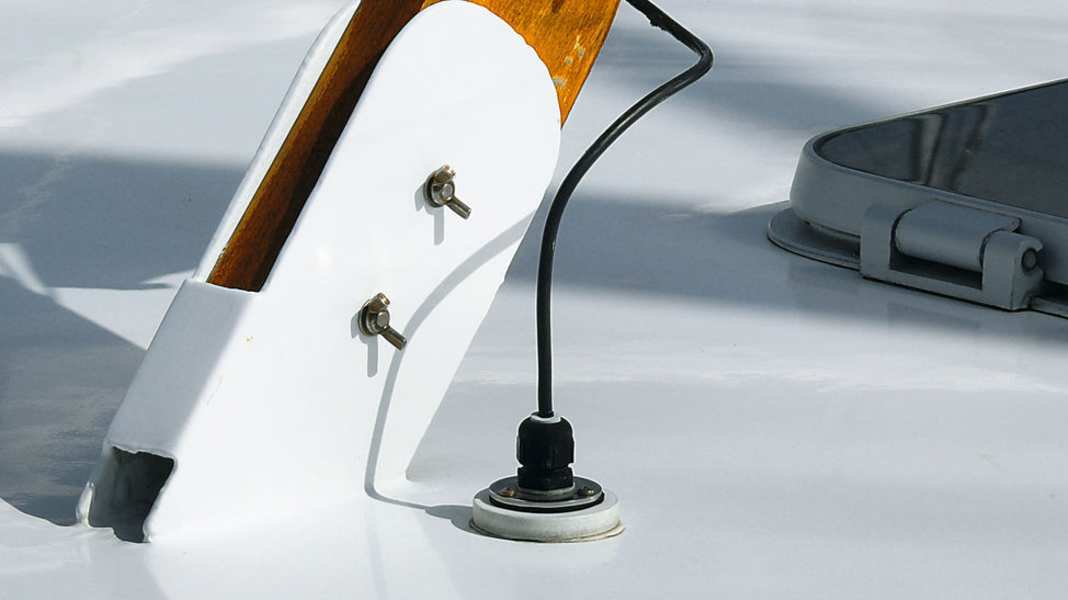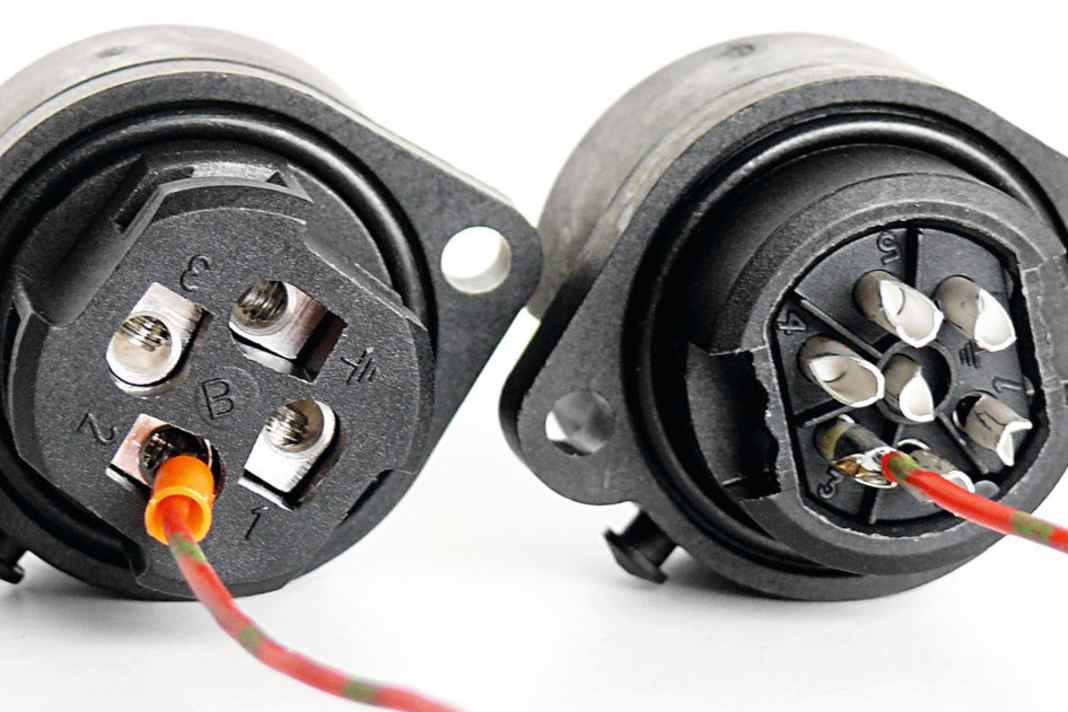
You face the problem with practically every new electronic system: How do you get the cables from the device below deck to the transducer on the superstructure? Nowadays, connection cables are usually supplied in sufficient length, but the skipper is on his own when it comes to the necessary disconnection point to the outside.
In principle, a distinction must be made betweenTwo variants must be distinguished: In the simpler case, the cable only needs to be routed to the outside in a watertight manner once and can remain installed in this way for the rest of its life, for example in the case of position lights. There are both ready-made fittings and solutions that can be created with on-board equipment.
It becomes more difficult if a detachable connection is required because the transmitter is mounted on a removable mast or device bracket, or in the case of devices that should not be left outside permanently due to the risk of an unforeseen change of ownership.






Then it depends on theType of cable on. The electrical requirements are low for power for deck or position lights, loudspeaker cables and slow data connections such as NMEA or SeaTalk, and the choice is wide. For VHF antenna and radar, for example, it is essential to use the appropriate connections; the minimum bending radii must also be observed, otherwise the function of the entire system will suffer.
Fixed implementations
If necessary, a cable without large connections can simply be glued into the hole with sealing compound. This can be done quickly and, if necessary, with on-board equipment. The appearance is of course secondary. If the cable does have to be removed at some point, the better your sealant was, the greater the effort involved. And it is guaranteed not to remain intact.
It is therefore more skilful to use a removable bushing, even for installations that appear final at first glance. This does not have to be an expensive plug - a flange with a seal that seals the cable watertight is completely sufficient. Electrical isolation is then carried out in the dry, for example with clamps. With both variants, the cable should not move in the area near the bushing, neither inside nor outside.
Otherwise the cores will break right in the passageway and you will have to dismantle the fixed installation much earlier than planned. If the cable to be laid has a large connector, there are also flange bushings with very large sealing inserts. In addition to the offers in the boat accessories trade, it is worth taking a look at industrial supplies: The keyword here isPG screw connection.
Demountable bushings
Unfortunately, there are also cables that cannot remain connected permanently, but must be disconnected regularly, for example forWinter storagemust be separated. You have two options here: The cable is routed through the deck and connected in the dry. This is easier to handle electrically, but is relatively large. Alternatively, the disconnection point can be a watertight deck plug located exactly in the feed-through.
Plug
In terms of design, this is the supreme discipline, with four problem areas to consider: the sealing of the actual plug connection, the insertion of the cable into the plug housing, the installation of the socket in the deck or superstructure and the mechanical load caused by footfall or movement.
There are three types of deck plugs available from outfitters today: The chrome-plated brass version is available with two to four poles and is quite popular due to its ship-like appearance. However, it is not always reliable due to its simple design. The seal consists only of a rubber disc between the housings.
If the union nut is not tightened properly or there is a crumb on the sealing surfaces, water can reach the contacts. Therefore, do not install where the sea comes right up to the plug on deck in rough weather. However, with protected positioning, careful installation and maintenance, even this favourable connection can provide a long service life.
This is much more professional thanPhilippi plug This is where the familiar black plastic model comes in. The chamber with the contacts is sealed with an O-ring, and this water protection works independently of the mechanical locking mechanism using a union nut.
The system is an industry standard and, if you don't make any major mistakes during installation, is very reliable. Although there are various manufacturers whose products are compatible, self-builders are almost exclusively offered byYacht chandler in question. This is the only place where you will find the version with the wires in the plug.do-it-yourself suitable with screw terminals be laid out.
This method is not common in the industrial sector when such high-quality connectors are required. Here, crimping or soldering is used, which most garages do not offer. The Philippi plug iswith up to seven polesThere is also a variant with additional coaxial connections, for example for radar systems.
In the "shore connection" department, many boat outfitters stock a plastic plug with an oval cross-section. Here, the seal works in a similar way to the Philippi system, but is locked by means of a lever mechanism. Disconnecting and connecting is quicker and more convenient than with the screw system - useful for the shore connection. However, as there is only a three-pole model, it can hardly be used for other areas.
Water on the wrong side
Even the best plug connection will only last for a short time if the installation leaves something to be desired. Slight leaks in the cable entry allow moisture to penetrate and dry out again - but not the plug. It then rots - invisibly - from the inside. The lamp on deck remains dark, although the plug itself looks good.
The disaster only becomes apparent after opening the housing. Even high-quality materials do not help, because when the system is switched on, there is usually a voltage between the contacts. Together with water, this creates a beautiful electrolytic cell.
So what can be done? The most important step is to ensure that all sealing surfaces are clean during installation and that the cable diameter matches the seal in the inlet. Many owners also seal the connections in the connector housing with water-repellent agents such as silicone grease - as a second layer of security, so to speak.
If you want to be on the safe side and have the opportunity, you should seal the connections with sealing compound; this also prevents water from penetrating the wires and damaging the cable over longer distances. Once a year, you should check that all screw connections are tight and that the cable is still properly seated. This is because the round seal only works on the round cable sheath and not if only the individual cores are still running through it.
Gooseneck
If you have space on deck, you can opt for less sophisticated technology. The cables and plugs are routed inwards through a gooseneck and connected there. The principle is based on gravity: in the gooseneck, the cables first run upwards from the outside to the inside so that no water can run into them.
If the whole thing is permanently submerged, it will of course no longer work. However, if there is a lot of water on deck, it is generally sufficient to stuff the remaining cavities in the gooseneck with a cloth. The gooseneck principle does not necessarily have to have the same dimensions as a fishing boat.
For pleasure craft, there are more compact versions that even render the lug useless. Here, too, the cables are first routed upwards, but the entire component is divided into two parts. Once the plugs have been threaded through, a cover closes off most of the opening, and the cables then lie in soft seals.
Gooseneck solutions are particularly practical: They usually manage with a single feed-through for all cables. This means you only have one hole in the deck or roof and don't need a large drill for subsequent extensions.
Conclusion
There are satisfactory solutions for the way through the deck. If problems occur permanently, it is worth thinking about changing the system - for example to a different make of plug or directly to a different principle.Olaf Schmidt

